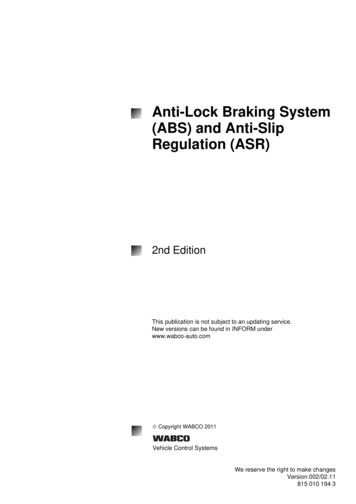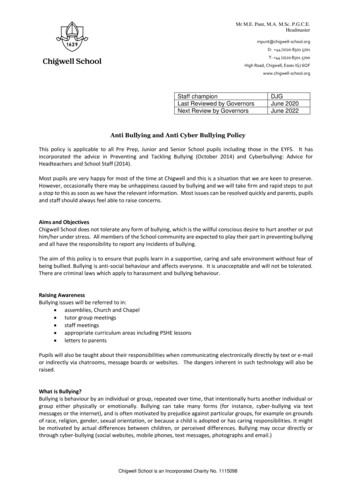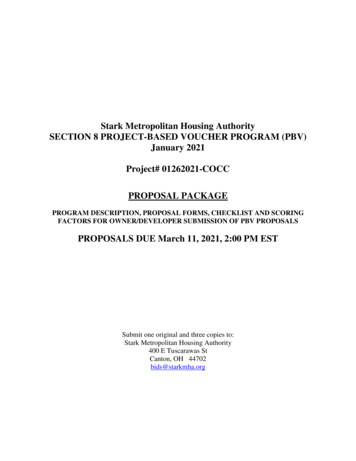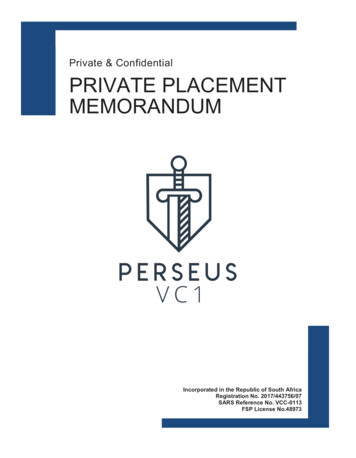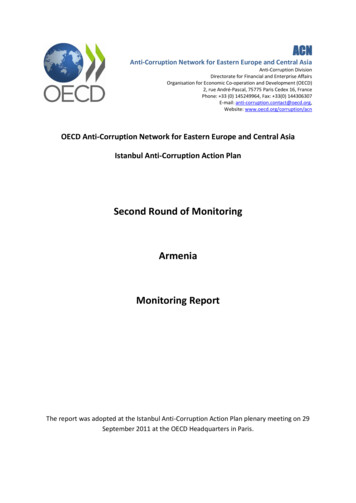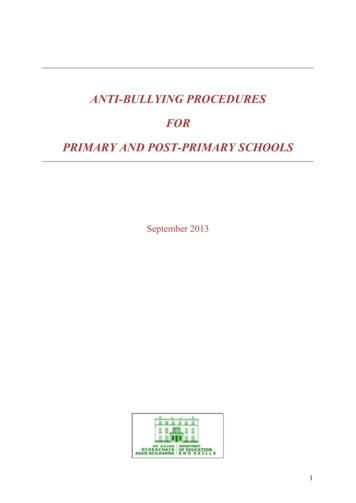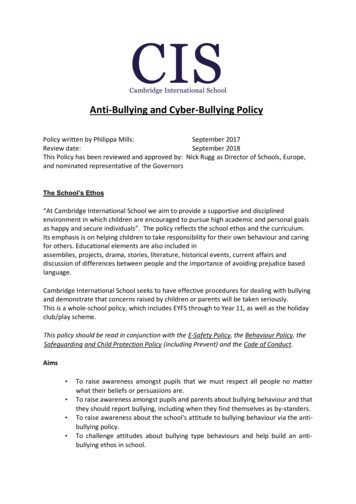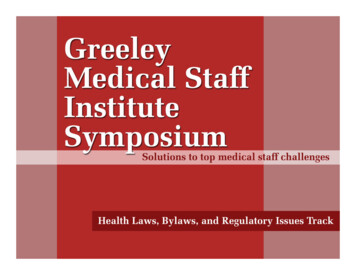
Transcription
Stark, Anti-kickback, andPrivate InurementFinding flexibility in what hospitals areallowed to do and how they can do itMichael R. Callahan, Esq.Katten Muchin Rosenman LLP
Stark Act The federal self-referral statute, commonly referredto as the “Stark Law,” provides that a physiciancannot:– Refer Medicare patients to an entity– For the furnishing of designated health services (DHS)– If there is a financial relationship between the referringphysician or an immediate family member and the entity Unless an exception applies– Stark prohibits an entity from presenting a Medicare claimfor a DHS that has been rendered pursuant to a prohibitedreferral
Stark Act (cont’d) Penalties for violating Stark include:– Denial of claims– Monetary penalties of up to 15,000 for each claimsubmitted as a result of a prohibited referral– A fine of up to twice the amount paid for the service– Exclusion from Medicare/Medicaid programs
Stark Act (cont’d) “Financial relationship” includes four differenttypes of relationships between a physician andan entity furnishing DHS:––––Direct ownership or investment interestIndirect ownership or investment interestDirect compensation arrangementIndirect compensation arrangement A physician who has any of the foregoingrelationships with a DHS provider cannot referMedicare or Medicaid patients unless anexception applies
Designated Health Services Clinical laboratory services Physical therapy, occupational therapy, and speech/languagepathology services Radiology and certain other imaging services Radiation therapy services and supplies Durable medical equipment and supplies Parenteral and enteral nutrients, equipment, and supplies Prosthetics, orthotics and prosthetic devices, and supplies Home health services Outpatient prescription drugs Inpatient and outpatient hospital services
New CMS Stark Regulations CMS goal:– Close perceived “loopholes” that permit allegedlyabusive financial relationships between hospitals andphysicians August 19, 2008: CMS publishes final Stark rules (73 Fed.Reg. 48434, 48688-48752) Effective Dates:– October 1, 2008– October 1, 2009 Practical effect:– Will require restructuring of many hospital-physiciantransactions
Definition of DHS Entity Current definition:– DHS Entity is the entity that bills Medicare for DHS New definition:– Effective October 1, 2009– DHS Entity is the entity that bills Medicare for DHS and the entity that has performedthe services that are billed as DHS Practical effect:– Will limit referring physician investments in entities that do not themselves bill for DHSservices, but provide them to hospitals “under arrangements” Problem:– CMS has declined to define the word “performs” CMS indication:– “Performs” has its “common meaning”– Permissible: Entities that solely lease equipment, provide management, provide billingservices or provide personnel to the entity performing the service
Example 1PhysiciansMemberJoint venture LLCServices agreementHospitalBillsMedicareMedicareSource: The Katten Muchin Rosenman LLP, Chicago.
Example 2HospitalMemberPhysiciansMemberJoint venture LLCServices agreementPhysician groupBillsMedicareMedicareSource: The Katten Muchin Rosenman LLP, Chicago.
Physician Owners “Stand in the Shoes”of Their Physician Organizations inRelation to DHS Entities CMS concern:– Stark law prohibition circumvented by routingcompensation through other entities between the physicianand the DHS entity New Rule Effective October 1, 2008– Owners of a physician organization “stand in the shoes” ofthat organization– However, physicians who are only employees of thephysician organization and physicians with only a “titularownership interest” (i.e., without the ability to receive thefinancial benefits of ownership) are not required to stand inthe shoes of their physician organization
Physician Owners “Stand in the Shoes”of their Physician Organizations inRelation to DHS Entities (cont’d) Effect:– Compensation provided by a DHS entity, such as a hospital, to aphysician group likely to be “direct compensation” to the referringphysician and will need to meet a Stark exception for a directfinancial relationship– Previously such compensation could qualify for “indirectcompensation” treatment and avoid the more rigid rulesapplicable to direct compensation– NOTE: Change not as expansive as originally proposed and issubject to a grandfather provision for pre-existing situations
Prohibition Against Unit-of-Serviceor “Per Click” Payments Prior Law– Unit-of-Service or “Per Click” payments were generally permitted New rule effective October 1, 2009:– “Per Click” payment methodologies are prohibited for leasingarrangements under the space and equipment lease exceptions, fairmarket value exception, and the exception for indirect compensationarrangements to the extent that these charges reflect services providedto patients referred between the parties Effect:– For example, prohibits a physician from leasing a CT scanner to ahospital on a “per click” basis if that physician refers patients to thehospital for CT services
Prohibition Against Unit-of-Serviceor “Per Click” Payments (cont’d) NOTE: Block time leases are not prohibited Must meet requirements for space and equipment leaseexception, including that the arrangements be fair marketvalue and commercially reasonable Abuse concerns– Small blocks of time and extended blocks of time
Prohibition Against Percentage-BasedCompensation for Rental of Office Spaceand Equipment New rule effective October 1, 2009– Prohibits the use of compensation methodologies based upon apercentage of revenue raised, earned, billed, collected, orotherwise attributable to the services performed or businessgenerated in the office space leased or by use of the leasedequipment NOTE: Prohibition does not apply to management orbilling services Lessor can charge lessee pro rata share of expensesattributable to leased portion CMS will monitor and may further restrict percentagebased methodologies in future
“Set in Advance” and Amendmentsto Agreements Stark law exceptions for rental of office spaceand equipment and personal services requirethat rental charges/compensation be “set inadvance” CMS original “set in advance” position:– Multi-year agreement for rental of office space orequipment or personal services could not beamended during its term without violating the “set inadvance” requirement
“Set in Advance” and Amendmentsto Agreements (cont’d) CMS new “set in advance” position:– An agreement can be amended as long as: All requirements of the applicable exception are satisfied; The amended rental charges/compensation are determinedbefore the amendment is implemented and the formula issufficiently detailed that it can be verified objectively; The formula for amended rates does not take into accountthe volume or value of referrals generated by the referringphysician; and The amended charges (or formula) remain in place for atleast one year from the date of amendment– Amendment rule applies to all compensationexceptions that include a one-year term requirement
The Anti-Kickback Statute The Federal Anti-kickback Statute generally makesit illegal to knowingly and willfully offer, pay, solicit,or receive any remuneration, directly or indirectly, inreturn for the referral of a patient or in exchange forarranging for an item or service payable, in whole orin part, under a federal healthcare program Can be remuneration in cash or in kind Intent to induce or pay for referrals must be proven Violations are punishable by imprisonment, trebledamages and fines of up to 50,000
Private Inurement Section 501(c)(3) of the Internal Revenue Code (the “Code” or“I.R.C.”) provides tax -exempt status for “[c]orporations . . .organized and operated exclusively for . . . charitable purposes” An organization is not operated exclusively for charitable purposes ifany part of its net earnings inures to the benefit of any privateshareholder or individual The prohibition on private inurement is absolute and, therefore, theincidence of any private inurement will result in the loss oftax -exempt status The Code and its regulations do not define private inurement. As aresult, whether private inurement occurs depends upon the factsand circumstances surrounding a transaction or arrangement
Private Inurement (cont’d) The private inurement prohibition applies to anorganization’s “net earnings.” The concept of netearnings permits an organization to pay orreceive “reasonable compensation” for a good orservice If, however, a transaction results in a hospitalpaying more than reasonable compensation foran item or service it purchases, or receiving lessthan reasonable compensation for an item orservice it sells, the transaction may result inprivate inurement
Private Inurement (cont’d) The IRS Audit Guidelines for Hospitals, ManualTransmittal 7(10) 69 -38, Exempt OrganizationsGuidelines Handbook (Mar. 27, 1992) (hereinafterthe “Hospital Audit Guidelines”) list the followingexamples of private inurement:– Excessive compensation– Receipt of less than fair market value in sales orexchanges of property– Inadequately secured loans– Other questionable loans– Payment of personal expenses of an insider that theorganization did not characterize as compensation, even iflater added to compensation and not in excess ofreasonable total compensation
Private Inurement (cont’d) The private inurement prohibition applies only to privateshareholders or individuals. Private shareholders or individuals arecommonly referred to as “insiders,” and include officers anddirectors. At times, the IRS has taken the position that all financialrelationships between a tax -exempt hospital and members of itsmedical staff are subject to the Code’s private inurementproscription Such as department heads, medical staff officers, or physicians withexclusive provider contracts The IRS also has stated that all persons performing services for anorganization may possess the requisite relationship to find privateinurement. Despite this, most newly recruited physicians are unlikelyto be deemed insiders for the private inurement proscription.
Private Benefit In addition to the proscription on private inurement,an exempt organization must serve public ratherthan private interests and cannot be operated for thebenefit of individuals with private interests in theorganization Unlike private inurement, the private benefitprohibition applies to all persons, not just insiders.On the other hand, the prohibition against privatebenefit is not absolute. An activity is permitted if theprivate benefit is merely incidental to the publicbenefit. The private benefit must be incidental inboth a qualitative and a quantitative sense.
Physician Recruitment and Retention –General Rule Under Stark The Stark II, Phase III recruitment exceptionprotects remuneration provided by a hospital torecruit a physician that is paid directly to thephysician or through the group and that is intendedto induce the physician to relocate his or her medicalpractice (or for new physicians to locate) to thegeographic area served by the hospital in order tobecome a member of the hospital’s medical staff General requirements:– The arrangement is set out in writing and signed by allparties, which may need to include the physician groupand the physician
Physician Recruitment and Retention –General Rule Under Stark (cont’d)– The arrangement is not conditioned on thephysician’s referral of patients to the hospital– The amount of remuneration under the arrangementis not determined in a manner that takes into account(directly or indirectly) the volume or value of anyreferrals by the referring physician
Physician Recruitment and Retention –New, Revised and Additional Standards Relocation– Physician must relocate his or her practice to thegeographic area served by the hospital Physician must move medical practice at least 25 miles; or Must establish that at least 75% of the physician revenuesfrom services provided by physician to patients, includinginpatients, are derived from services provided to new patientsnot seen or treated at prior medical practice site during thepreceding three years measured on an annual basis (fiscal orcalendar year)
Physician Recruitment and Retention –New, Revised and Additional Standards For initial “start up” year, 75% test is satisfied if there is areasonable expectation the practice will derive 75% ofrevenues from new patients not treated at prior practiceduring preceding three years Medical Staff Membership– Recruited physician cannot already be a member ofthe hospital’s medical staff– The fact that a physician may have been a courtesyor locum tenens member who had little or no activityis irrelevant
Physician Recruitment and Retention –New, Revised and Additional Standards– Recruited physicians cannot be prohibited fromestablishing staff privileges at other hospitals or fromreferring to other hospitals, even if these hospitals arecompetitors “The exception does not prevent hospitals from imposingreasonable credentialing restrictions on physicians when theycompete with the recruiting hospital. Such restrictions mustnot take into account the volume or value of referrals”– Statement is somewhat vague but suggests that restrictionscan be imposed that would preclude ownership in a competingsurgi center, for example. Need to see if this point is furtherclarified
Physician Recruitment and Retention –New, Revised and Additional Standards Geographic area served by the hospital– Geographic area served by the hospital is defined asthe area comprised of all of the contiguous ZIP codesfrom which hospital draws fewer than 75% of its inpatients (see discussion on rural hospital below) Use to be the lowest number of contiguous zip codes– The term “contiguous ZIP codes” does not mean onlyZIP codes that are contiguous to a ZIP code in whichthe hospital is located, but ZIP codes that are next toor contiguous to each other
Physician Recruitment and Retention –New, Revised and Additional Standards– Hospital should look at in-patient data to determinewhere patients live and then calculate lowest numberof ZIP codes that touch at least one other ZIP code inwhich the inpatients reside– If all of the contiguous ZIP code areas account forless than 75% of the hospital’s inpatients, the hospitalis limited to recruitment into those areas– If a ZIP code area has, for example, only large officebuildings or commercial district and has no patients, ahospital may recruit into this “hole” ZIP code
Physician Recruitment and Retention –New, Revised and Additional Standards– If multiple configurations containing the same numberof ZIP codes permit the hospital to meet the 75% (or90% for rural hospitals), hospital is entitled to use anyof the configurations– The date on which the 75% (or 90%) standard appliesis the date on which the parties have signed thewritten recruitment agreement – recognizes thatservice areas may change with different recruitmentarrangements– Even if a hospital is part of a health system, thestandard is hospital and not health system specific
Physician Recruitment and Retention –New, Revised and Additional Standards Payment guarantee by group practice– A hospital may seek to have a physician groupguarantee repayment of any monies advanced to thegroup on behalf of the recruited physician if, forexample, physician does not fulfill community servicerequirement– It does not let the hospital off the hook from itsobligation to go after the physician for breach ofcontract or other claims or failing to meet communityservice or other related obligations under therecruitment arrangement
Physician Recruitment and Retention –New, Revised and Additional Standards– Comments make the particular point that hospitalsare obligated to collect any amounts owed by thephysician or the physician practice making theguarantee because if collections are not sought, thiswould be viewed as remuneration to the grouppractice or the recruited physician and would need tobe analyzed under the Anti-kickback Statute
Physician Recruitment and Retention –New, Revised and Additional Standards Allocation of group practice costs to recruitedphysician– General rule is that a group practice may only takeinto account the “actual costs incurred by the . . .physician practice in recruiting a new physician . . .”when determining payment to the referred physicianunder an income guarantee– Stated differently, the group is not permitted to divideexpenses on a pro rata basis among all physicians,including newly recruited physicians, if no additionalexpenses have been incurred
Physician Recruitment and Retention –New, Revised and Additional Standards For example, if a physician joins a four-person practice withbut no additional employees are hired, no new employeeexpenses have been incurred and therefore cannot beconsidered an incurred cost– Actual costs incurred for recruitment efforts by thegroup such as head hunter fees, airfare, hotel, meals,costs associated with visits, moving expenses,telephone calls, tail insurance and other relatedexpenses, can be included in the cost allocationassessment
Physician Recruitment and Retention –New, Revised and Additional Standards– A hospital may pay a physician group for time spent in therecruitment of a physician as long as the requirements ofthe reasonable compensation exception have been met It is irrelevant whether the recruited physician did or did not jointhe group for purposes of this exception– Where recruited physician is replacing “a deceased,retiring, or relocating physician in an underserved area”the practice may, when calculating an income guarantee,use a per capita allocation of the practice’s aggregateoverhead and other expenses as long as it does notexceed 20% of the practice’s aggregate cost or use thealternative method of allocating the actual additionalincremental costs to the practice
Physician Recruitment and Retention –New, Revised and Additional Standards Physician must join group practice– For the exception to apply, the recruited physicianmust be a physician in the group practice or amember of the group. The exception does not applyto a physician who simply leases space andequipment from the group at the same location. As apractical matter, the hospital cannot provide supportto the group practice for this arrangement, includingthe use of income guarantees.
Physician Recruitment and Retention –New, Revised and Additional Standards Practice Restrictions– In a major reversal, Stark II, Phase III now permitsreasonable restrictions on a recruited physician’sability to practice medicine in the geographic areaserved by the hospital– Although not completely deferring to state and locallaws regarding noncompete agreements, thecommentary states that “we believe that any practicerestrictions or conditions that do not comply withapplicable State and local law run a significant risk ofbeing considered unreasonable”
Physician Recruitment and Retention –New, Revised and Additional Standards– The result of this reversal is that hospitals and grouppractices may utilize different but reasonable practicerestrictions including, but not limited to: Restrictive covenants and non-compete clauses Reasonable liquidated damages clauses Restrictions on moonlighting Prohibitions on soliciting patients and/or employees of thephysician practice
Physician Recruitment and Retention –New, Revised and Additional Standards Requiring that the recruited physicians treat Medicaid andindigent care patients Requiring that a recruited physician not use confidential orproprietary information of the physician practice Requiring that recruited physicians repay losses of his or herpractice that are absorbed by the physician practice inexcess of any hospital
Michael R. Callahan, Esq. Katten Muchin Rosenman LLP. Stark Act The federal self-referral statute, commonly referred to as the “Stark Law,” provides that a physician cannot: – Refer Medicare patients to an entity
